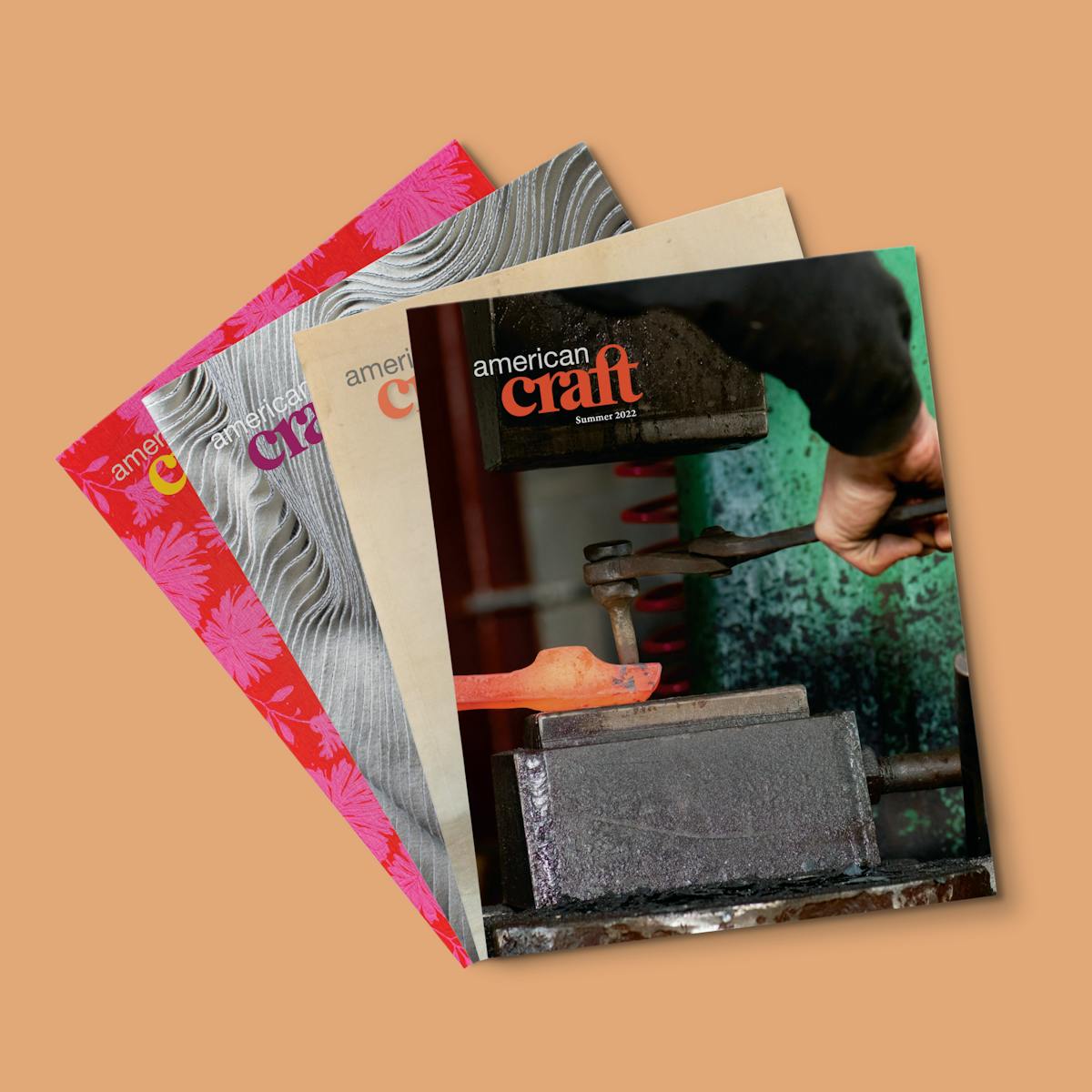Forging New Paths
Forging New Paths
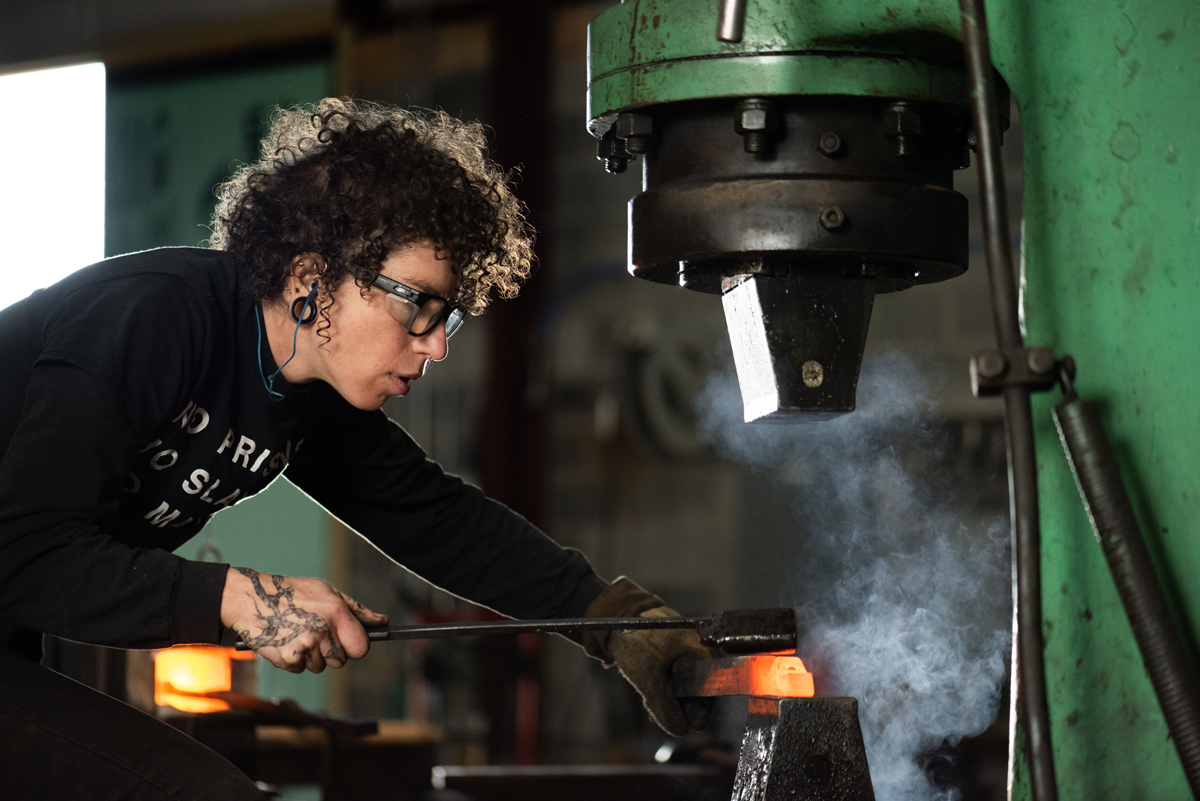
Rachel David, winner of the 2021 James Renwick Alliance for Craft Chrysalis Award, forging in her studio. Photo by Loam.
Rachel David: Earth and Flesh
Recipient of the 2021 James Renwick Alliance for Craft Chrysalis Award, Rachel David lives and works in Waynesville, North Carolina. She builds large pieces of sculptural furniture using a mixture of forged and repoussé steel. Two vulnerabilities, of the earth and of flesh, appear and reappear in her work. The surfaces of her furniture resemble landscapes disrupted by extractive mining and harvesting, like roads riding high across depleted farmland or pipelines stretching long into the distance. She arranges dense furrows and hollows, dented and dappled by hammer blows and held by forged grids. The work also references the textural unevenness of flesh, interrupted by scars and cellulite and restrained by what look like elastic bands.
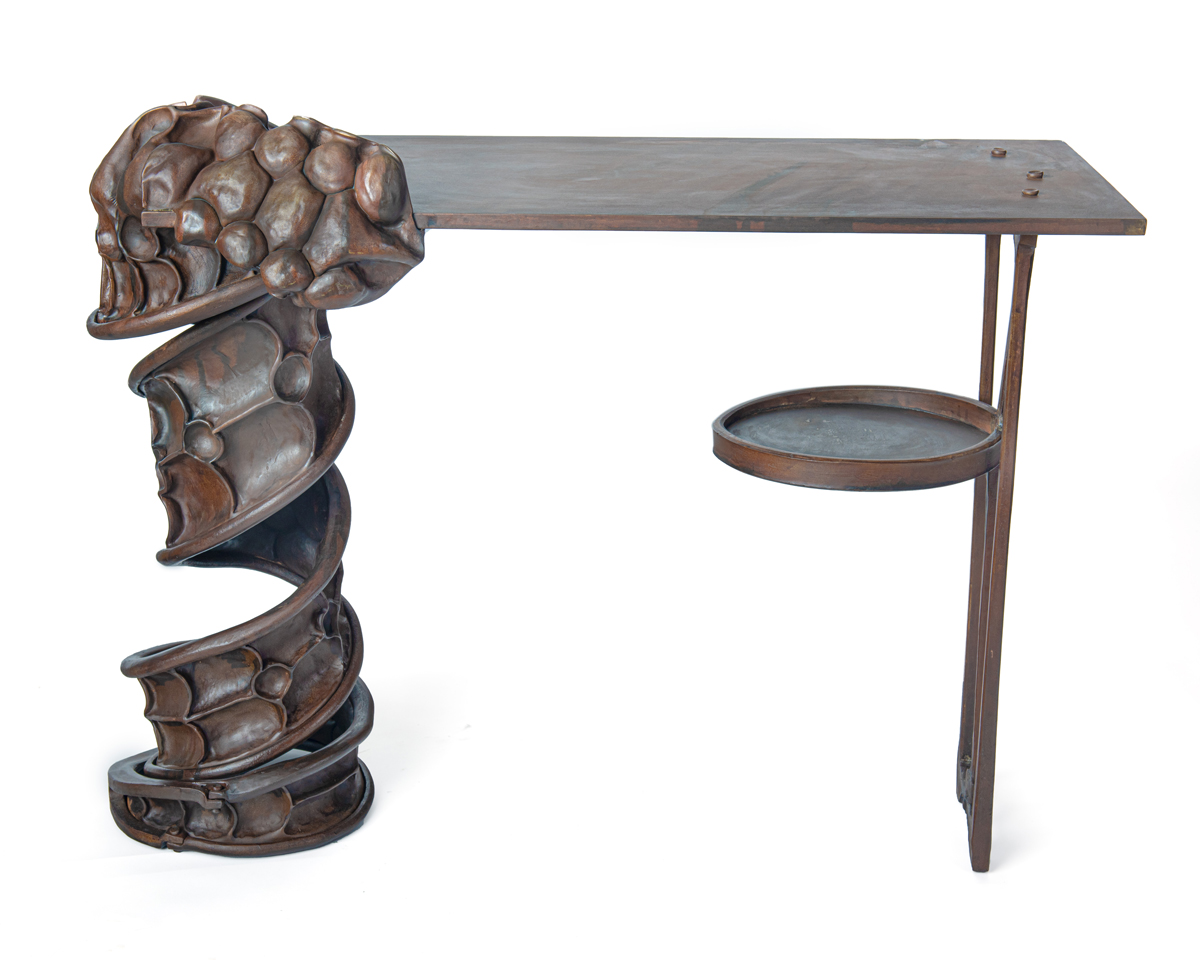
Helix table, 2020, made from forged, formed, and fabricated steel. 33 x 42 x 20 in. Photo by Sesthsasak Boonchai.
David uses pneumatic hammers to forge concave and convex shapes into steel sheets. Her pneumatic tools come in a variety of sizes: some are handheld while others, too heavy to operate solo with finesse, are suspended from overhead hoists. She uses a lot of fuel to shape the material in what she describes as a “violent but efficient process.”
“I keep metal screaming hot,” she says. “I don’t use a coal forge. I use gas forges and have a couple of sizes. I use a torch all the time. Make it bigger, get it faster, hit it harder.”
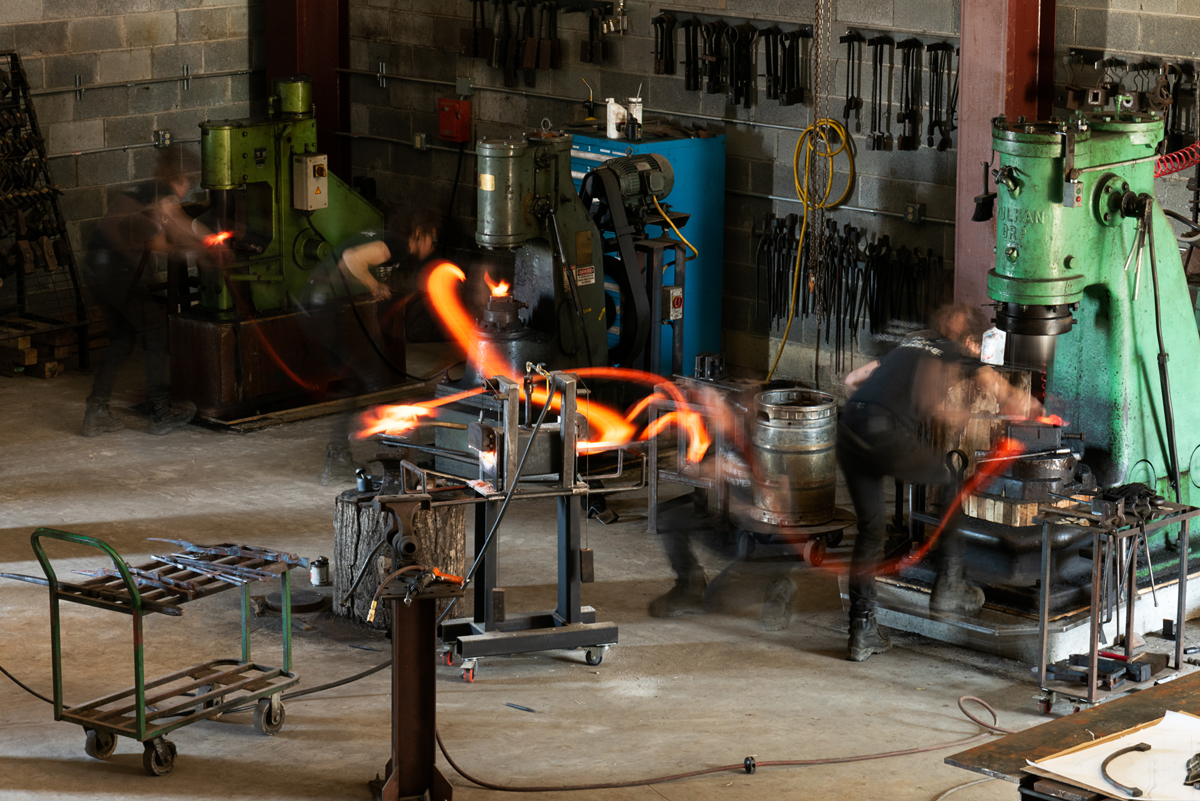
A time-lapse photo of Rachel David moving from forge to different hammers to make a part for a light project. Photo by Loam.
An Oberlin College dropout, David learned welding through a project to convert diesel-powered cars to run on vegetable oil and then worked with Elizabeth Meadows to learn welding and coppersmithing techniques. From 2003 to 2004, she attended Evergreen State College in Olympia, Washington, and through the Evergreen program, she attended an eight-week intensive course in blacksmithing. Then, through Penland connections, she moved to New Orleans to follow a job constructing glass-building equipment; she lived there 16 years, during which time she was involved in activism, including anti-war protests and alternative communities like pirate radio.
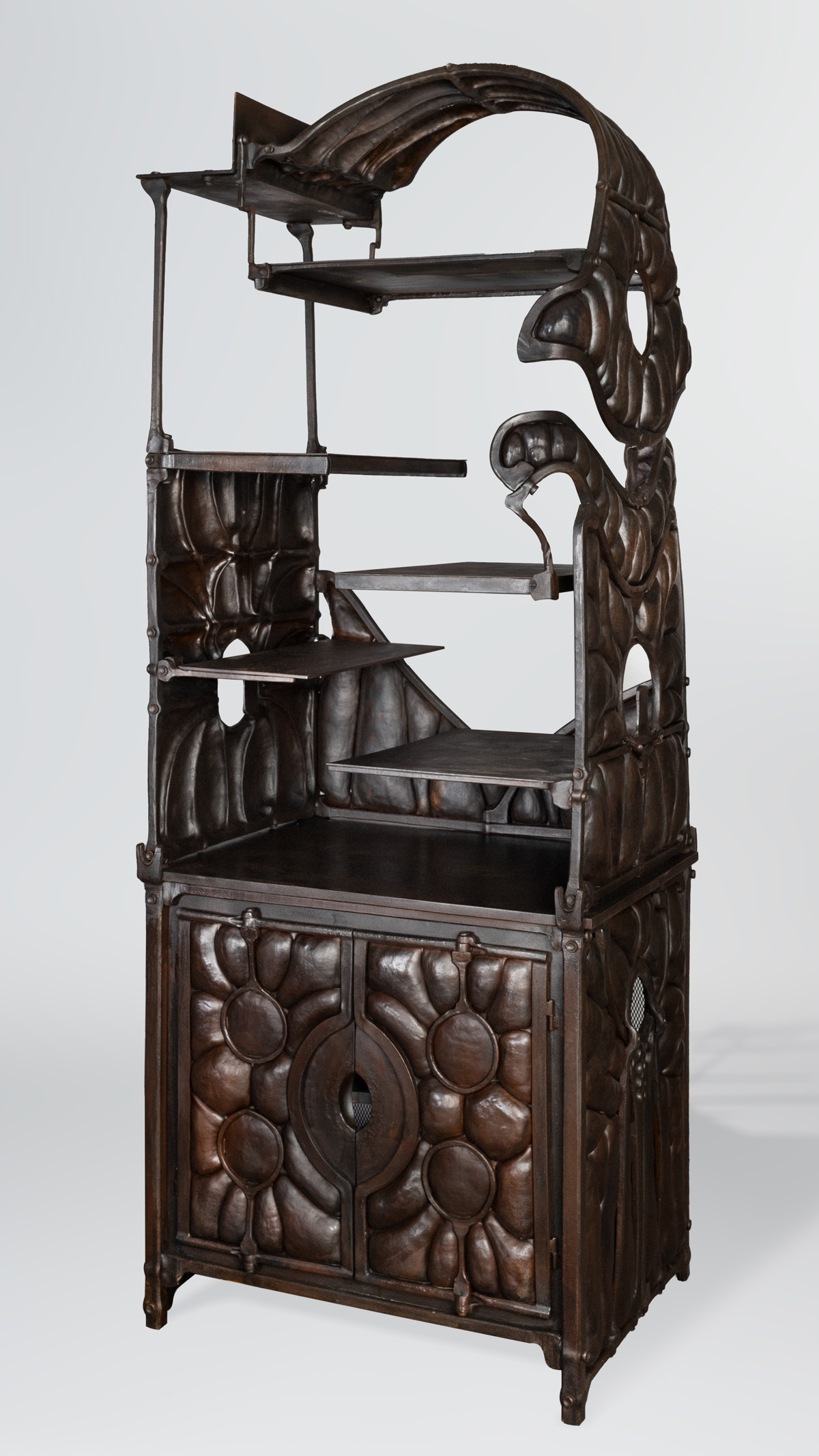
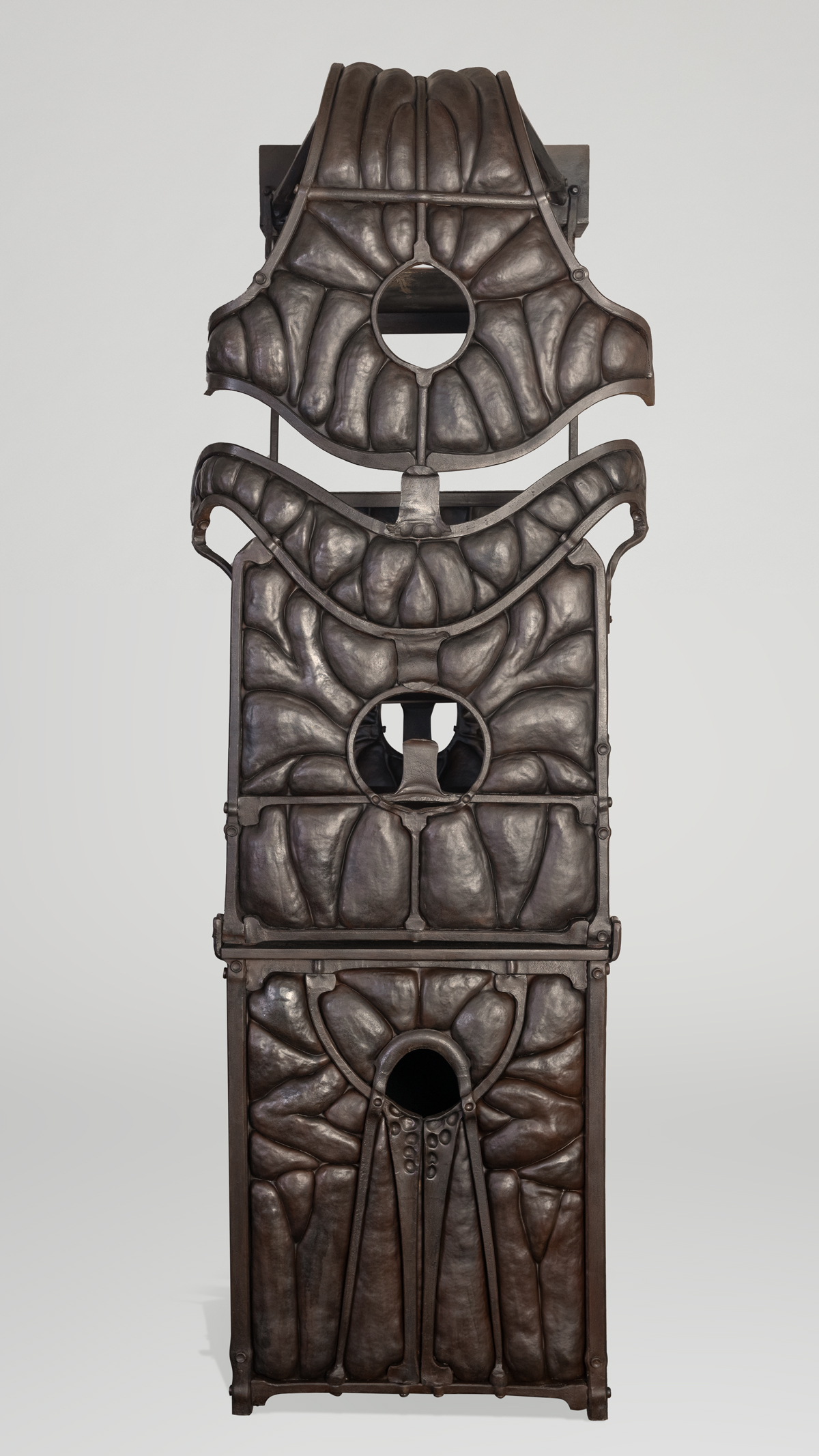
David created this custom curio cabinet, 2019, from forged, formed, and fabricated steel. 92 x 32 x 22 in. Photos by Sesthsasak Boonchai.
Because of her concern about the human impact on the environment, fueled by her experience living in New Orleans before, during, and after the devastation of Hurricane Katrina, David struggles to balance her love of the forging process with blacksmithing’s resource-consuming nature. She points out the negative impact blacksmithing has had on global wellbeing, too, by enabling the Atlantic slave trade (with shackles and chains), gun manufacturing, and industrialization with its continuous global trade. ”It’s a really important part of history that this field and crafts in general kinda try to skip over,” says David. “It’s ugly, and we should be more honest about our participation and how some have benefitted while others clearly have not.”
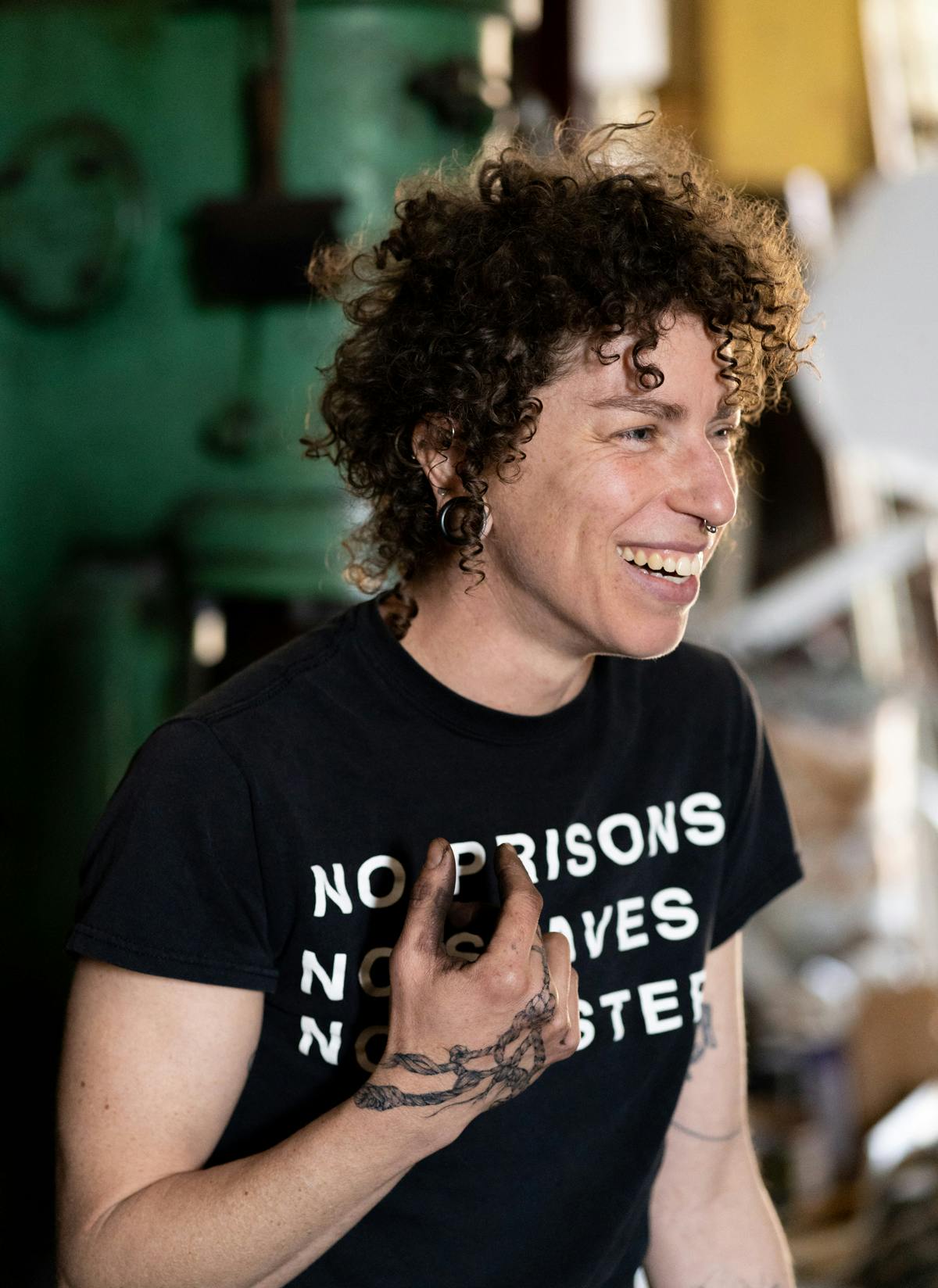
Though she creates bespoke luxury furniture for an elite clientele, David takes time to educate potential clients on the challenging ideas behind her work and the amount of labor, materials, and time their creation requires, through conversation at the craft and furniture shows where she displays her pieces. “Every commission is a compromise,” she says, “but I love it. I am so lucky that my jobs are awesome and my clients are open. I get to be creative and do pretty much what I want within the boundaries of what’s okay.”
While her ideas and political stance don’t resonate with everyone, she forms lasting relationships with the people for whom they do. These relationships are both financially and emotionally sustaining, keeping her shop funded and her creative spirit engaged.
Rachel David. Photo by Loam.
Elizabeth Brim: Ribbons, Bows, and Hammer Blows
Elizabeth Brim is best known for translating steel—hard, cold, and unyielding—into domestic objects that imply a sense of home and hominess. Taking inspiration from her mother’s and grandmother’s skills in decorating, dressmaking, and millinery, she found her niche creating realistic-looking pillows, aprons, shoes, and hats.
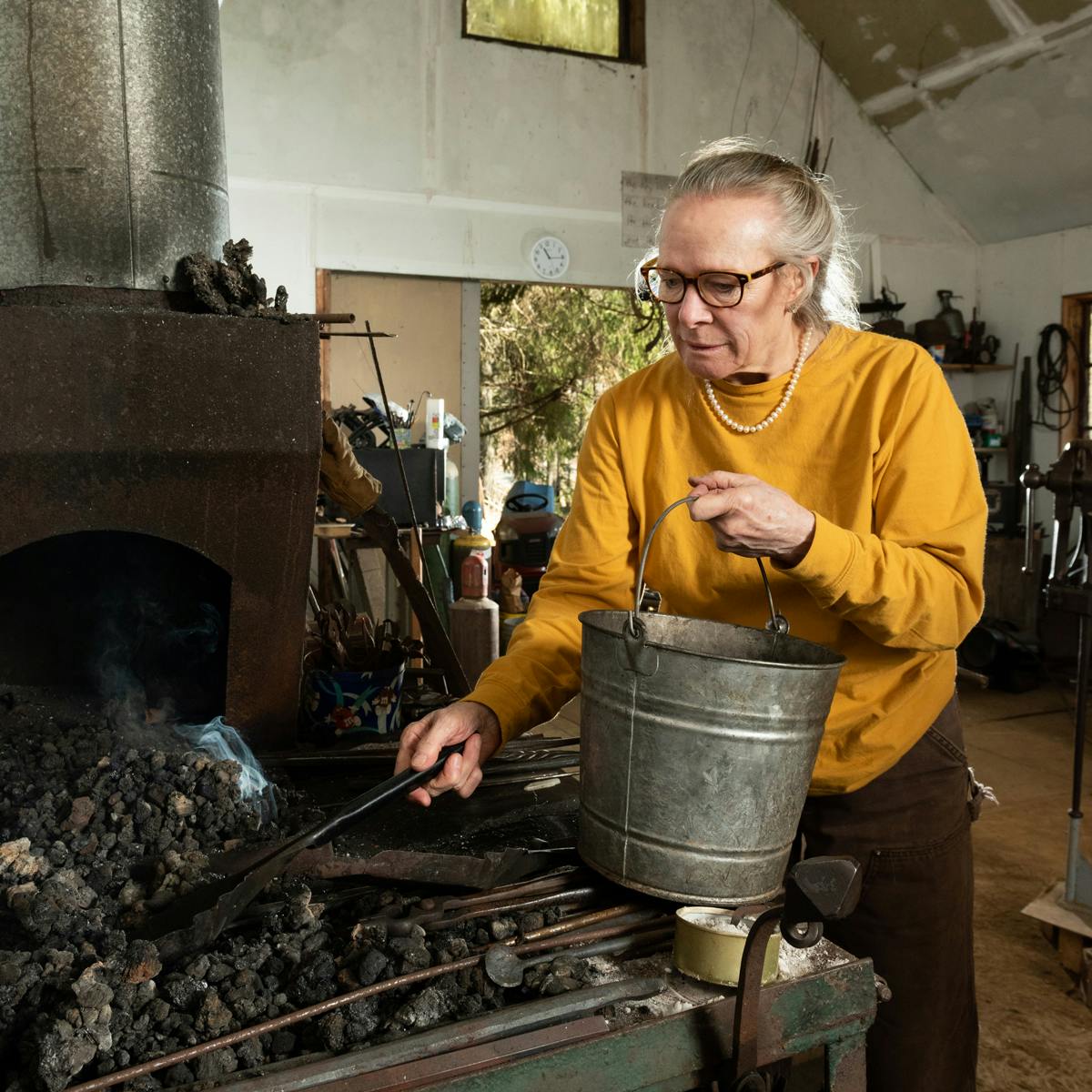
Brim adds coal to her forge fire. Photo by Loam.
Her steel pillows, decorated with textured or tufted surfaces and twisted tassels, ruffles, and other textile-inspired trim, look ready to be tossed on a couch. The ribbons on her hats and high-heeled shoes appear to flutter in the wind, the steel dynamic and light. She captures the essence of aprons, each one with a different floral pattern embossed in the steel, as the repoussé steel fabric gracefully drapes and folds. The true-to-life representation of these objects requires a mastery of both material and skills that hides the rigor of the making process—forge, hammer, and tongs. By using traditional blacksmithing techniques to create these domestically centered objects, Brim challenges conventional ways of thinking about blacksmithing.
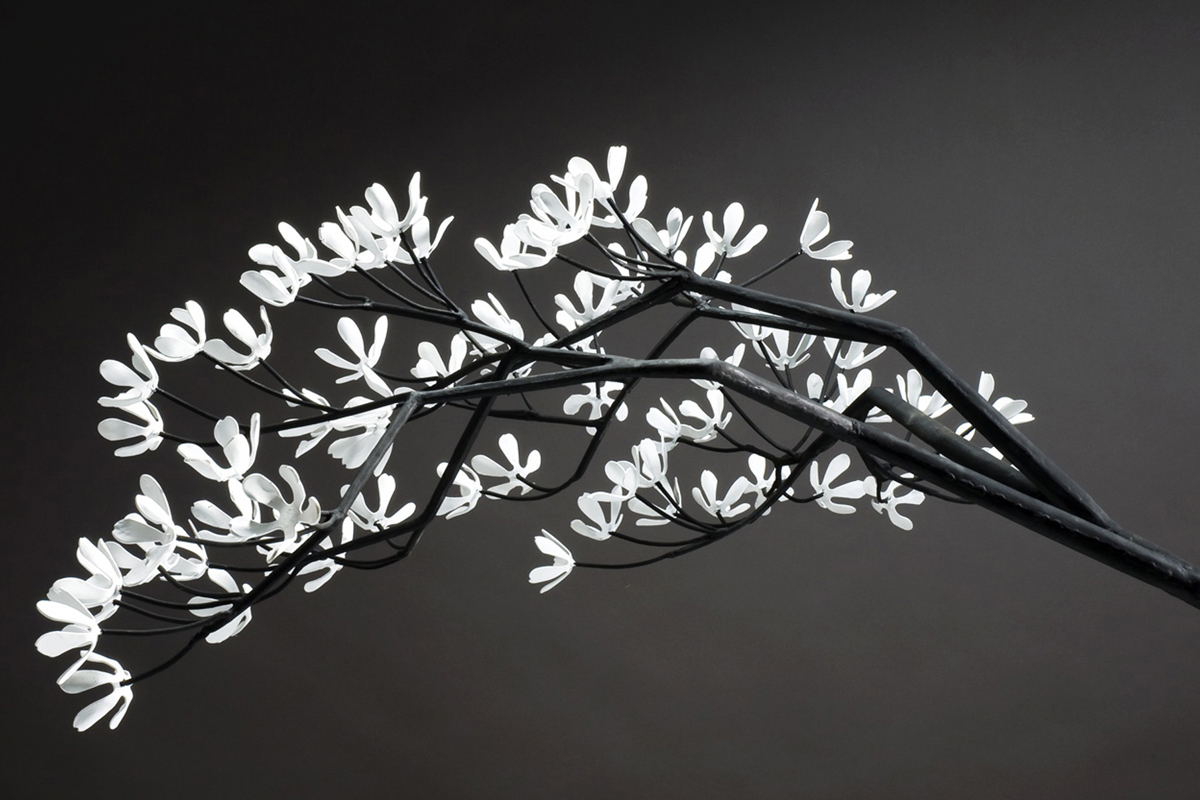
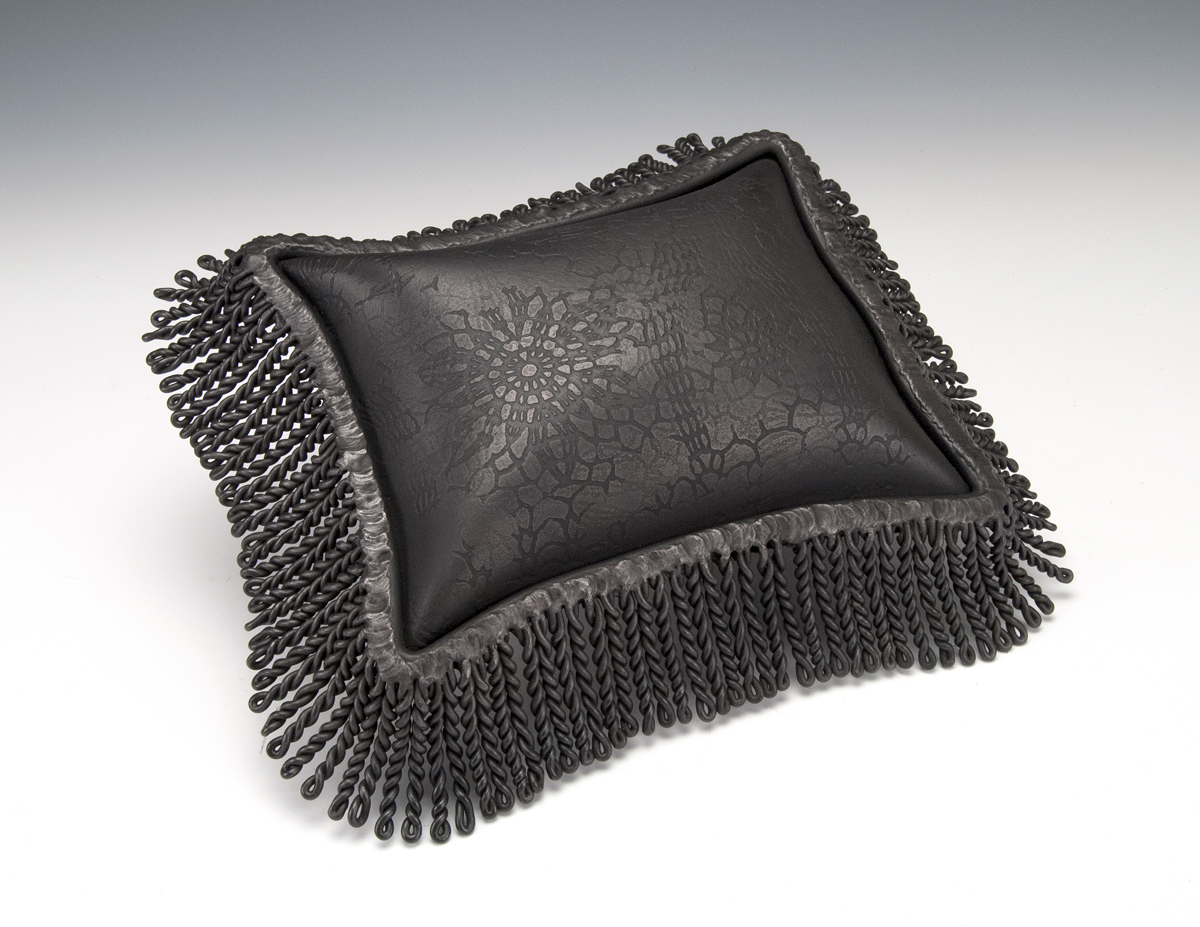
TOP: Elizabeth Brim’s public art project Serviceberry (detail), 2014, is forged and fabricated steel with paint, 17 x 6 x 6 ft. Photo by Tom Mills. BOTTOM: Gothic, 2016, is a pillow in fabricated, inflated, and etched steel with twisted steel fringe, 3.5 x 16 x 14 in. Photo by Kathryn Gremley / Penland Gallery.
Born in Columbus, Georgia, but now based in Penland, North Carolina, Brim trained as an artist in hopes of becoming a teacher, an appropriate profession for a genteel Southerner in the late 1970s. She graduated with a master’s degree in printmaking from the University of Georgia, but she also worked with ceramics and jewelry. At a summer class at Penland School of Craft in 1984, when she needed help making a tool for another class, she visited a blacksmithing workshop led by Doug Wilson, became fascinated, and never left.
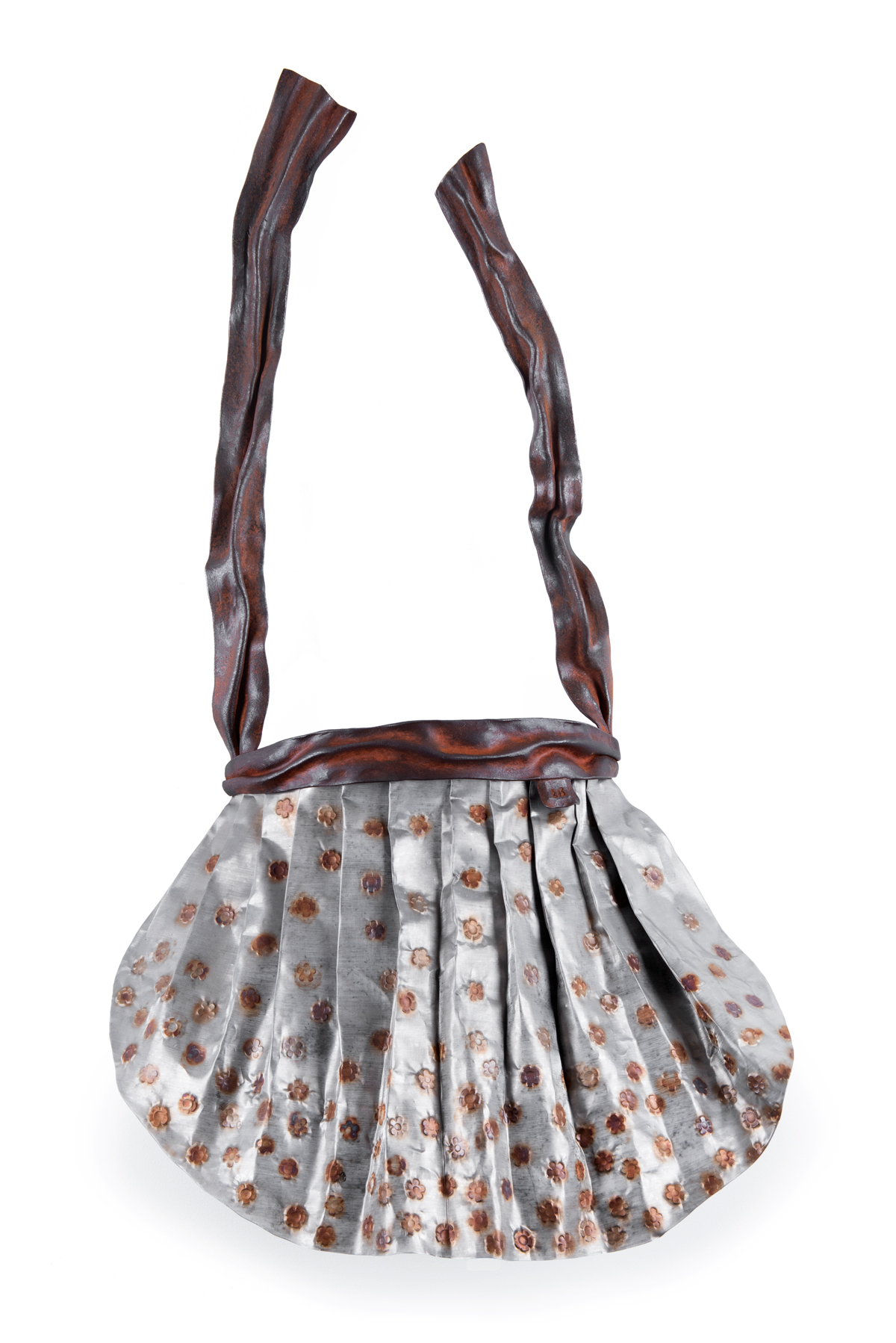
Rise and Shine, 2020, an apron made of forged and fabricated mild steel, rusted, with a mesh skirt of embossed, heat-colored stainless steel, 36 x 24 x 10 in. Photos by Brady Connelly.
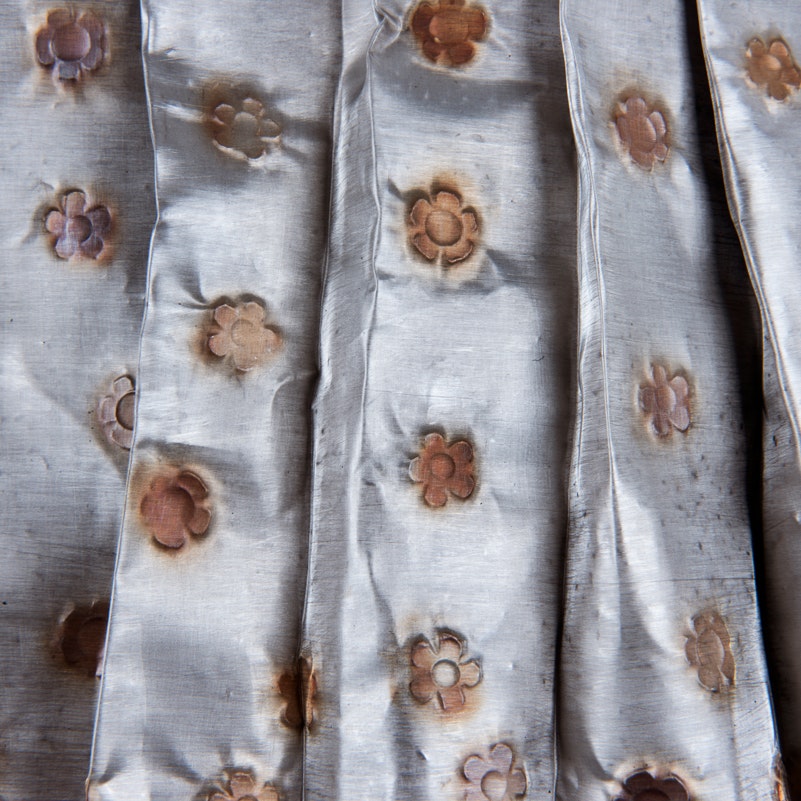
As she began her journey into this field, rooted in brawny tradition, she knew she would meet resistance. “Because I was a woman with a Southern accent, wearing pearls and a bow in my hair, I would have gotten attention anyway,” she says. “So I decided I needed to make technically impressive work, very well crafted, to gain the respect of the blacksmithing community.” And gain respect she did, winning first prize at the 1988 Artist-Blacksmith’s Association of North America (ABANA) Southeastern Regional Conference, and then receiving the Alex Bealer Award in 2010 in recognition of her impact on the field. There was no denying the technical virtuosity required to make a steel ribbon appear to be floating on a nonexistent breeze.
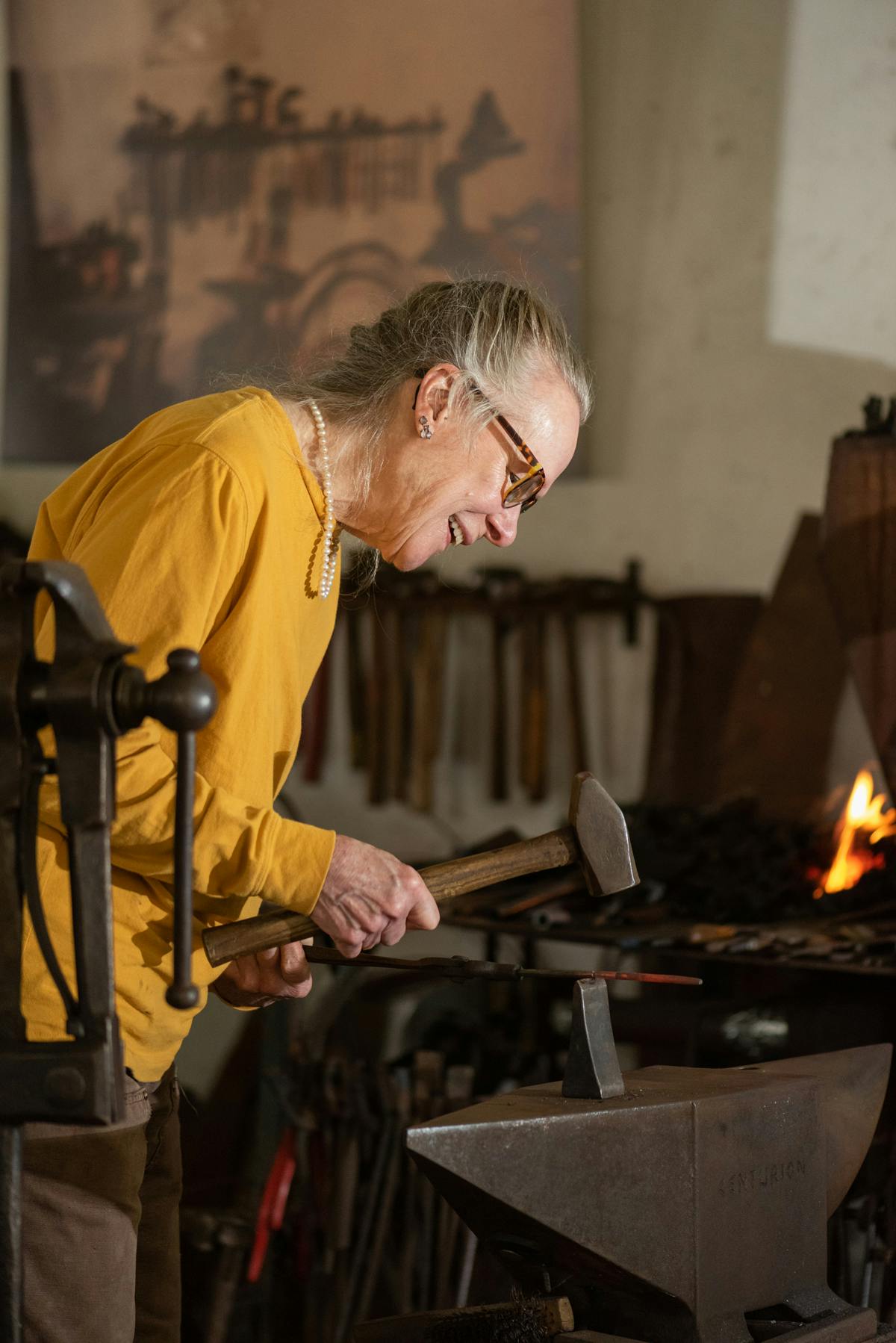
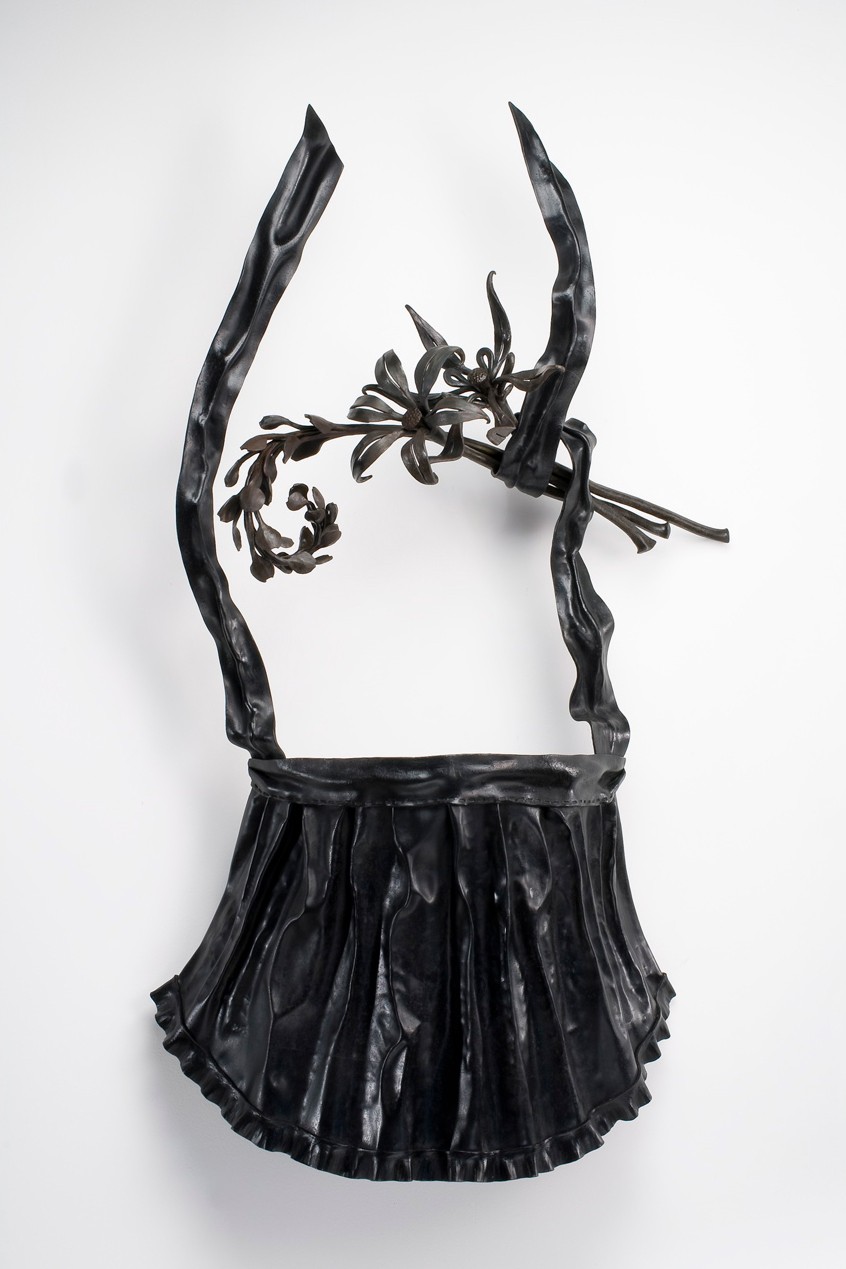
LEFT: Brim uses a tool called a hardy to cut a piece of red-hot metal in two. RIGHT: Brim’s Catch, 2008, is made of forged and fabricated steel that’s painted, 36 x 16 x 7.5 in. Photos by Loam.
Ellen Durkan: The Edge of Style in Steel
Ellen Durkan creates architectural ironwork, the mainstay of a modern blacksmith, with forged leaves, scrolls, and other flourishes made using techniques recognizable over the centuries: tapers, rivets, tenons, and collars. However, she places her ironwork on an active, living body instead of the exteriors of buildings. Her “gates” are wearable and protective pieces, hinged around the curves of a human body, simultaneously playful and powerful. Her work is “visual and metaphorical armor,” she says. “My starting foundation is always the body. That’s what my canvas is.”
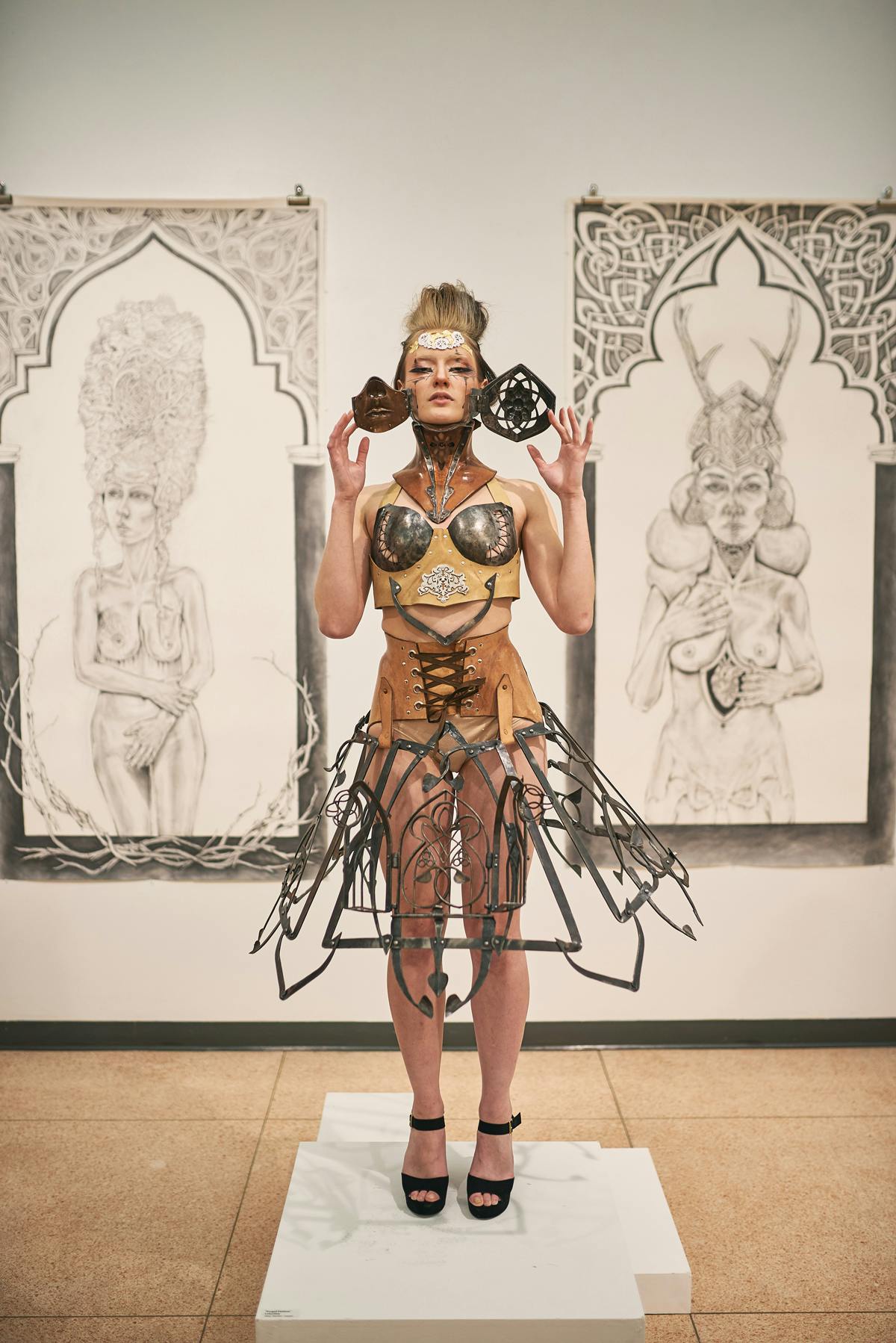
Model Damara wears Speak, a work of visual and metaphorical armor that’s part of Ellen Durkan’s Forged Fashion collection, at Durkan’s solo show Behind Her Iron Gates at the Delaware College of Art and Design in 2019. Photo by Joe Hoddinott.
In 2009, Durkan received her MFA in sculpture from Towson University in Maryland. During this program she started exploring metalwork, welding large, stationary steel frames, covering them with hand-sewn fabric, and then putting people inside. She calls them “dress cages.” While still in graduate school, she attended Peters Valley School of Craft and began to learn the structural capacity of steel and the potential of blacksmithing. She worked as an assistant to Dick Sargent at the Peters Valley forge and credits that experience with a major shift in her work. As the work evolved, Durkan stripped away the fabric and focused on the steel forms without moving away from the theme of wearability and the central importance of the body. Her work, she says, is a “full-body experience.” When people wear it, she says, “I want them to feel good. I want them to feel kick-ass. There’s a transformation that happens when they get into the work. It’s like giving people a little bit more power or self-confidence that maybe they didn’t know how to tap into."
Based where she grew up, in Wilmington, Delaware, Durkan stages runway shows during fashion weeks around the world, including Sydney in 2015 and Paris in 2014, to activate her work on different bodies. She recently attended Katsucon, an anime conference in Washington, DC, wearing her steel pieces to great acclaim. The pieces are adjustable via a series of leather straps, a one-size-fits-many approach. Her style—a mashup of retro 1950s and mythic elven fantasy with gothic architectural references—challenges perceptions of what blacksmithing can be.
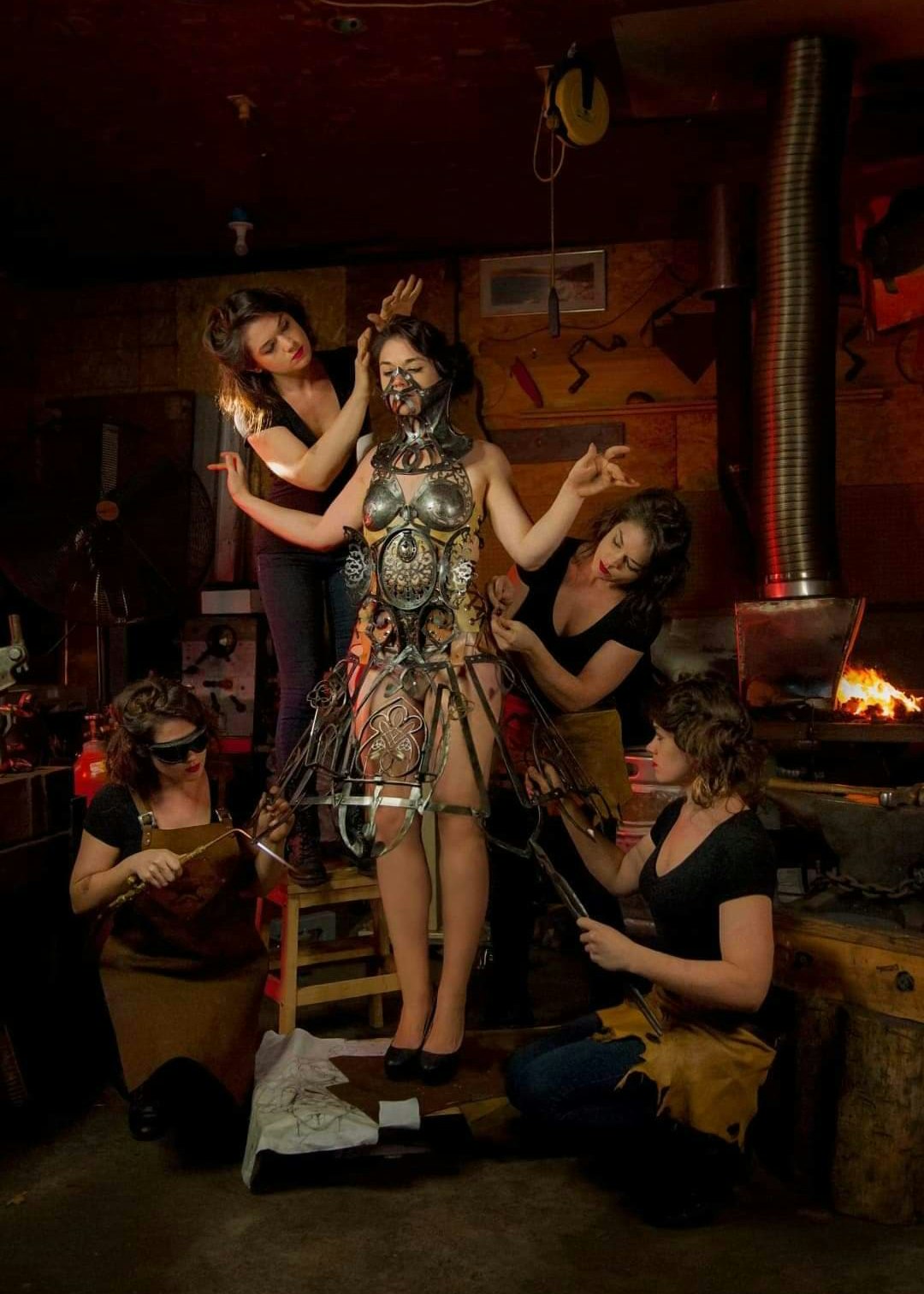
In this composite photo, made of five separate images, Durkan dresses herself in her piece Forge of the Iron Maiden. Photo by Ric Frane.
She often appears wearing her work in collaborative photography projects with Joe Hoddinott, an artist specializing in photo, illustration, and design. In 2018, the pair produced a video called Speak featuring Durkan’s work being worn by different women; it was later used by Planned Parenthood’s “Bans Off Our Bodies” campaign. The photographs are also shown with Durkan’s work when it’s on display, providing visual context when the work isn’t being actively worn. Durkan and Hoddinott’s familiarity with each other’s work and styles sparks conversations that ignite new ideas and creates a safe space for experimentation, especially when Durkan’s body is the subject of the photograph.
Durkan’s fashion- and body-focused pieces generate strong emotional responses. She has a massive following of vigilant defenders and appreciators of her work, but she also is subject to all kinds of harassment online, from ribald comments to unsolicited images. Through it all, she embraces the power of radical vulnerability, unabashed in her right to forge her own creative path—internet trolls be damned. Her reimagining of ironwork as fashion reasserts the physicality of the forging process in an unconventional way and casts a new light on the strength necessary to be a blacksmith today.

Jess, 2019, an ensemble made and named for the model wearing it, in Durkan’s Forged Fashion collection. Photo by Joe Hoddinott.
Hisses and Cheers
The resistance Durkan has met has also been experienced by the other blacksmiths, in varying ways. The cultural space of blacksmithing includes a broad range of people, from artists to hobbyists to traditionalists to, as Durkan knows all too well, the just plain ornery. Within these ranks, there are some who question artistic experimentation, heaping scorn and disdain on anyone trying something new. They note that a great deal of technical gatekeeping exists within the field, as if there were only one way to be a blacksmith or only one way to utilize a technique.
On the bright side, all three artists point to relationships with other smiths who, either at pivotal moments early in their careers or in an ongoing way as long-term mentors, have been supportive of their unconventional approaches—people such as Elizabeth Meadows, Doug Wilson, and Dick Sargent. These like-minded smiths welcomed and respected their desire to make work that challenged what it means to be a blacksmith.
Sometimes opposed, often supported, David, Brim, and Durkan persist. They work to create welcoming spaces for all comers by teaching workshops, giving lectures, and speaking up about their experiences of harm. David is one of the founding members of the Society of Inclusive Blacksmiths (see page 56), encouraging and welcoming racial and gender diversity in the field. Brim champions the smiths who come through Penland School of Craft as an unofficial ambassador of the school’s Iron Studio, staying connected with and supportive of the many blacksmiths who filter through. Through her activities at cosplay conventions and workshops and her photography, Durkan challenges what blacksmiths look like and where they can show up. The art, the activities, and the beliefs of these fearless practitioners prove that blacksmithing can look ahead to a bright and innovative future.
redmetal.net | @__redmetal__
elizabethbrim.com | @halfroundbastard
ellendurkan.com | @ironmaidenforge
Discover More Inspiring Artists in Our Magazine
Become a member to get a subscription to American Craft magazine and experience the work of artists who are defining the craft movement today.

